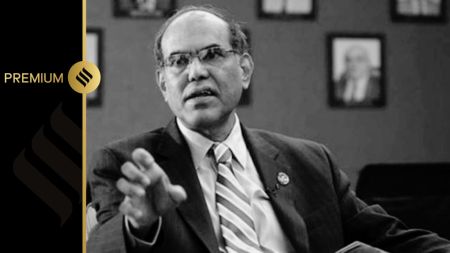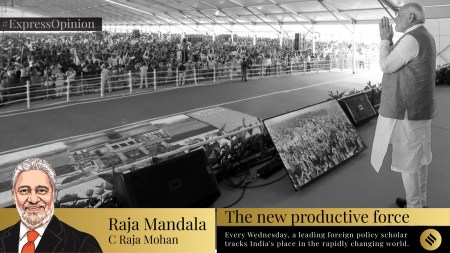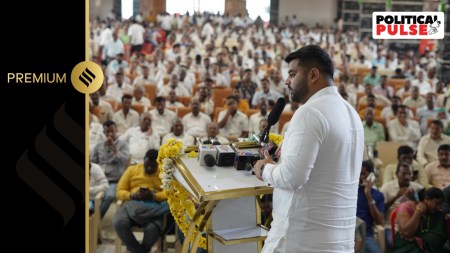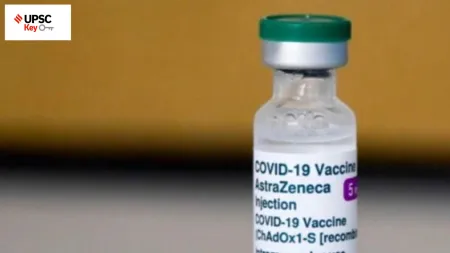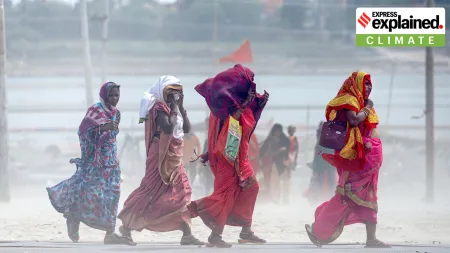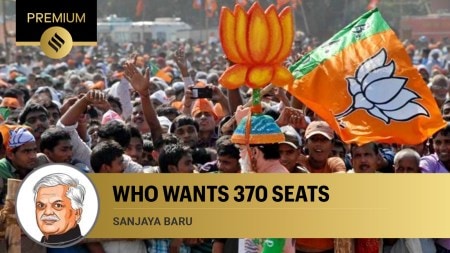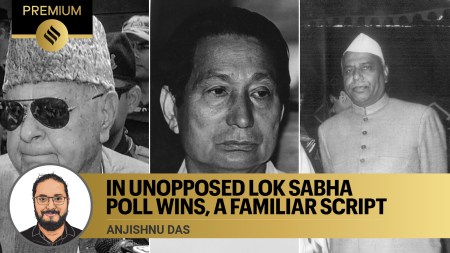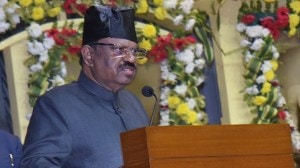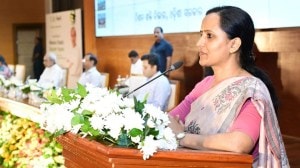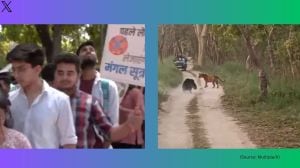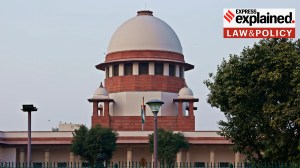- India
- International
UPSC Key— 19th April, 2024 | India’s 4P model, LGBTQIA+ rights, Left-wing extremism and more
Exclusive for Subscribers from Monday to Friday: How India’s 4P model and LGBTQIA+ rights are relevant to the UPSC Exam? What significance do topics like Left-wing extremism and Artificial intelligence have for the preliminary and main exams? You can learn more by reading the Indian Express UPSC Key for April 19, 2024.
 In fact, the WHO recommends that adults themselves should not get more than 10 per cent of their calories from sugar and ideally push it down to less than five per cent. Know more in our UPSC key today. (File Image)
In fact, the WHO recommends that adults themselves should not get more than 10 per cent of their calories from sugar and ideally push it down to less than five per cent. Know more in our UPSC key today. (File Image)Important topics and their relevance in UPSC CSE exam for April 19, 2024. If you missed the April 18, 2024 UPSC CSE exam key from the Indian Express, read it here.
🚨 The Indian Express UPSC Essentials brings to you the April edition of its monthly magazine. Click Here to read. Share your views and suggestions in the comment box or at manas.srivastava@indianexpress.com🚨
Editorial Page
Clash of aspirations
Syllabus:
Preliminary Examination: Economic and Social Development- Sustainable Development, Poverty, Inclusion, Demographics, Social Sector Initiatives, etc.
Mains Examination: General Studies III: Indian Economy and issues relating to planning, mobilisation of resources, growth, development and employment.
What’s the ongoing story- Amartya Lahiri writes– “The unfolding clash of aspirations of workers and entrepreneurs in India has the potential to convert India’s demographic dividend into a demographic curse if the country cannot find ways of employing its young workers in jobs that meet their aspirations. Dealing with the issue should be at the top of the agenda of the next government.”
Prerequisites:
— What is the demographic dividend?

— What is the difference between demographic transition and demographic dividend?
— What are the various stages of demographic transition?
Key takeaways:
— During the current century, India has experienced a couple of decades of economic growth rates that have been significantly greater than the growth rates in the first four decades post-independence. However, limited employment opportunities for the growing young populations presents the biggest challenge in the path of maximum utilization of India’s demographic dividend.
— Amartya Lahiri writes- “India’s demographic dividend is, however, a double-edged sword. On the one hand, it presents the country with a short window during which it will have a huge supply of young workers and human capital. On the other hand, it presents the country with a severe challenge in matching these workers to productive jobs.”
— The ongoing transformation of India’s economy from primarily agrarian to more non-agrarian also presents two challenges to the labour market.
— First, people’s skills need to change in order to successfully transit from the agricultural sector to either manufacturing or services.
— Second, migration of workers from rural to urban areas since non-agricultural employment opportunities tend to be in urban centers far from rural India. Migration is costly, both monetarily and socially, imperfections in the process can act like a massive handbrake for the economy.
— The small size of firms in India (both in terms of employment and revenue) and skill deficit is a problem for the Indian economy.
— The unfolding labour market situation in India is perhaps best described as a clash of aspirations. On one side we have a plethora of entrepreneurs and firms with very limited aspirations to grow. On the other side of the market is a big pool of workers whose numbers are swelling by 10 million a year.
— Any solution to the unfolding labour market crisis will require private manufacturing firms to scale up their ambitions. A self-sustaining way to achieve that would be to incentivise exports. Available evidence suggests that firms that export tend to be larger and more productive.
Points to Ponder:
— What is the significance of India’s demographic dividend?
— What are the challenges associated with India’s demographic dividend?
— At what stage India is in the four stage model of demographic transition?
— What measures should be taken to best utilise India’s demographic potential?
Post Read Question:
Prelims
India is regarded as a country with a “Demographic Dividend”. This is due to (2011)
(a) Its high population in the age group below 15 years
(b) Its high population in the age group of 15-64 year
(c) Its high population in the age group above 65 years
(d) Its high total population
Mains
Why the unfolding labour market situation in India is perhaps described as a clash of aspirations. Explain.
Other Important Articles Covering the same topic:
The 360° UPSC Debate: India’s Growing Population- Dividend or Burden?
Experts Explain | Demographic dividend and unemployment problems in India
How India can leverage its biggest strength
Express View
Opening up
Syllabus:
Preliminary Examination: Current Events of national and international importance, Economic development
Mains Examination: General Studies Paper-2: Government Policies & Interventions, General Studies Paper-3 Liberalisation, Space Technology, Achievements of Indians in Science & Technology.
What’s the ongoing story- The Finance Ministry has notified amended rules under the Foreign Exchange Management Act to operationalise its earlier decision to allow up to 100 per cent foreign direct investment (FDI) for the space sector. The new rules came into effect from April 16.
Prerequisites:
— What do you understand by foreign direct investment (FDI)? What are the different routes and components of FDI in India?
— What is the difference between FDI and FPI?
— What is Foreign Exchange Management Act?
Key takeaways:
— The policy to allow up to 100 per cent foreign direct investment (FDI) for the space sector approved by the Union Cabinet in February, is also of a piece with its drive to position India as a space power. It allows 74 per cent FDI under the automatic route for satellite manufacturing and data products, 49 per cent for launch vehicles and spaceports, and up to 100 per cent for manufacturing components required by the sector.
— India’s share of the global space economy is between 2 and 3 per cent. The government has plans to increase it to more than 10 per cent by 2030.
— The Space Policy introduced in April last year redefined ISRO’s role and tasked the agency with research and development. The policy also recognised the private sector as an important stakeholder. Relaxing entry barriers for FDI is a continuation of the thrust on capturing a large share of the global space economy.
— Currently, ISRO operates spaceports in the country. By allowing 49 per cent FDI in the segment, the government seems to be signalling its intent to make the ecosystem more enabling for private companies.
For Your Information:
— Foreign Direct Investment (FDI) is defined as an investment in which a company takes controlling ownership of a business entity in another country. Therefore, foreign companies get directly involved with day-to-day operations in other countries.
— Indian National Space Promotion and Authorization Center (IN-SPACe) is an independent nodal agency under Department of Space for allowing space activities and usage of DOS owned facilities by NGPEs as well as to prioritise the launch manifest.
Points to Ponder:
— What are the Recent Amendments in the FDI Policy of India?
— What are the challenges associated with the entry of private players in the space sector in India?
— Which are the sectors that fall under the 100% automatic route and government route categories?
— How will recent FDI amendments benefit the Indian space sector?
— What are the major developments in the space sector in India?
— What are the key features of Indian Space Policy 2023?
— Read about Aditya L1, Chandrayaan 3 and other important Indian space missions.
Post Read Question:
Discuss India’s achievements in the field of Space Science and Technology. How the application of this technology helped India in its socio-economic development? (2016)
Other Important Articles Covering the same topic:
Ahead of Elon Musk visit, Finance Ministry notifies new rules backing FDI tweaks for space sector
A larger role for private sector in new space policy is a step in right direction
UPSC Key— 18th April, 2024 | FDI in space sector
Rights and Wrongs
Syllabus:
Preliminary Examination: Economic and Social Development – Sustainable Development, Poverty, Inclusion, Demographics, Social Sector Initiatives, etc
Mains Examination: GS-II, Welfare schemes for vulnerable sections of the population by the Centre and States and the performance of these schemes; mechanisms, laws, institutions and Bodies constituted for the protection and betterment of these vulnerable sections
What’s the ongoing story- Given the tenor of conservatism that has generally guided its views on LGBTQIA+ rights, including its opposition to the legalisation of same-sex marriage in the country, the Centre’s notification of a committee “to examine the various issues relating to the queer community”, honouring its undertaking to the Supreme Court (SC) in October last year, is welcome.
Prerequisites:
— What is Section 377 of the Indian Penal Code?
— Who constitutes the LGBTQIA+ communities?
— Same sex-marriage
Key takeaways:
— On the direction of the Supreme Court of India, the Center has notified a committee chaired by the Cabinet Secretary “to examine the various issues relating to queer community.”
— Express opinion: “Legislative intentions have often appeared to be out of sync with ground realities — a survey conducted by Pew Research between June 2022 and September 2023, for instance, showed that 53 per cent adults were in favour of legalising same-sex marriages.”
— The community’s rights barely feature as election issues. This year, only the Congress manifesto speaks of a “law to recognise civil unions between couples belonging to the LGBTQIA+ community” and the CPI(M)’s of “legal recognition and protection to same-sex couples similar to marriage-‘civil union’/’same-sex partnerships’”.
— The BJP has promised insurance coverage to transgender individuals under the Ayushman Bharat scheme and wider access to Garima Grehs.
For Your Information:
— The six-member committee will comprise secretaries from the Ministry of Home Affairs; Ministry of Women and Child Development; Ministry of Health and Family Welfare; Ministry of Social Justice and Empowerment and the Law Ministry.
— On October 17, 2023, a five-judge Constitution Bench of the Supreme Court led by Chief Justice of India D Y Chandrachud declined to recognise the right to marry as a fundamental right for same-sex couples.
— Among the legal entitlements listed out by the SC are: the right of queer partners to be treated as part of the same family for a ration card; setting up of a joint bank account; jail visitation; to be considered “next of kin” by medical practitioners, and accessing the body of the deceased partner to arrange the last rites.
Points to Ponder:
— Challenges faced by the LGBTQIA+ community in India
— What does the government need to do for social inclusivity?
— What changes can be made at grassroot level for gender sensitisation?
— Mental Health issues related with LGBTQIA+ communities?
Post Read Question:
How do laws concerning marriage equality and adoption rights affect LGBTQIA+ communities, and what challenges do they encounter?
Other Important Articles Covering the same topic:
Centre notifies panel led by Cabinet Secretary on issues of queer community
Supreme Court says no to same-sex marriage: All you need to know about the top court’s verdict
The Ideas Page
India’s 4P model
Syllabus:
Preliminary Examination: Economic and Social Development – Sustainable Development, Poverty, Inclusion, Demographics, Social Sector Initiatives, etc.
Mains Examination: GS-II, Welfare schemes for vulnerable sections of the population by the Centre and States and the performance of these schemes; mechanisms, laws, institutions and Bodies constituted for the protection and betterment of these vulnerable sections. Issues relating to development and management of Social Sector/Services relating to Health, Education, Human Resources.
What’s the ongoing story- Parameswaran Iyer writes: At the World Bank-IMF spring meetings this week in Washington DC, a particular event came to my attention: a ministerial-level consultation to follow up on the 2023 Paris Pact for People and the Planet (4P), which seeks, among other objectives, to ensure that no country should have to choose between fighting poverty and fighting for the planet. I was reminded of an earlier 4P formulation that came out of the Mahatma Gandhi International Sanitation Conference (MGISC) held in Delhi in October 2018.
Prerequisites:
— What is the Paris Pact for People and the Planet (4P)?
— What are the Sustainable Development Goals (SDGs)?
— What is the Swachh Bharat Mission(SBM)?
Key takeaways:
— “At the Mahatma Gandhi International Sanitation Conference (MGISC) held in Delhi in October 2018 a set of 4Ps were declared as India’s formula for achieving developmental results on the ground. These were — political leadership, public financing, partnerships and people’s participation.”
— “The 4Ps emerged from the transformational programme, the Swachh Bharat Mission (SBM), which aimed at eliminating open defecation through a mass movement or jan andolan of behavioral change.”
— “The 4 Ps have successfully been applied to other national programmes in India, including LIFE (Lifestyle for the Environment), the Jal Jeevan Mission and many more.”
Points to Ponder:
— Role of public participation in ensuring good governance
— Spillover effect of the SBM
— What outcomes can be expected from the Paris Pact for People and the Planet (4P)?
Post Read Question:
The success of India’s welfare schemes like the Swachh Bharat Mission (SBM) is a guiding light for other countries. Analyse.
Other Important Articles Covering the same topic:
Climate finance needs private funding too. This is how it can be done
Explained Page
Report flags sweetened Nestle products: how added sugar harms babies
Syllabus:
Preliminary Examination: General Science
Mains Examination: General studies-III: Science and Technology- developments and their applications and effects in everyday life.
What’s the ongoing story- Nestlé’s products for babies in Asia, Africa and Latin America were found to contain added sugars, while the same products sold in Europe did not have it, according to a recent report.
Prerequisites:
— What is sugar?
— What are added sugars and sweeteners?
— Read about the Food Safety and Standards Authority of India (FSSAI)
Key takeaways:
— The report (‘How Nestlé gets children hooked on sugar in lower-income countries’) faulted Nestlé for employing different nutritional standards in its offerings, depending on the country it served. Nestlé also did not make the quantity of sugar content clear on the products’ packaging, it said.
— Sugar is a simple carbohydrate. Some food items have sugar that is naturally occurring. According to the American Heart Association (AHA), it is “found in milk (lactose) and fruit (fructose). Any product that contains milk (such as yogurt, milk or cream) or fruit (fresh, dried) contains some natural sugars.”
— In 2015, the WHO’s guideline recommended that “adults and children reduce their daily intake of free sugars to less than 10% of their total energy intake.” WHO advises against the introduction of added sugars before the age of 2.
— Excessive sugar consumption can lead to increased overall energy intake in a person’s overall diet. It may be at the cost of food items having nutritionally adequate calories, eventually leading to an unhealthy diet. The risks of contracting non-communicable diseases, such as diabetes, obesity and heart-related ailments, are then increased. Tooth decay is also associated with early exposure to sugar.
For Your Information:
— According to a new Lancet study, India has seen a steady increase in obesity levels — not only in adults but children too — over the last 32 years. At the same time, the prevalence of undernutrition has also remained high in the country. As a result, India has become one of the countries with a high “double burden,”.
— According to the World Health Organisation (WHO), obesity is an abnormal or excessive accumulation of fat that poses health risks.
Points to Ponder:
— Why are added sugars harmful?
— What are the impacts of obesity and undernutrition on health?
— What initiatives has the Indian Government taken for promoting nutrition security?
Post Read Question:
Prelims
Which of the following is/are the indicators/ indicators used by IFPRI to compute the Global Hunger Index Report? (2016)
1. Undernourishment
2. Child stunting
3. Child mortality
Select the correct answer using the code given below:
(a) 1 only
(b) 2 and 3 only
(c) 1, 2 and 3
(d) 1 and 3 only
Mains
In the context of steady increase in obesity levels and prevalence of undernutrition, explain how India has become one of the countries with a high “double burden”.
Other Important Articles Covering the same topic:
Obesity on the rise, high levels of undernutrition persist in India: What a new study says
How malnutrition and obesity are linked in India
Anti-Maoist operations status report
Syllabus:
Preliminary Examination: Current events of national and international importance.
Mains Examination: GS-III, Linkages between development and spread of extremism, role of external state and non-state actors in creating challenges to internal security.
What’s the ongoing story- At least 29 alleged Maoists were killed in a gunfight with security forces in the forests of southern Chhattisgarh’s Kanker district on Tuesday (April 16), exactly 10 days before the district goes to polls in the upcoming Lok Sabha elections on April 26. The operation is the largest (in terms of Maoists’ bodies recovered) since the creation of Chhattisgarh in 2000, and among the biggest successes for security forces in their decades-long fight against left-wing extremism (LWE).
Prerequisites:
— What is left-wing extremism (LWE)?
— Origin of Naxalism in India
— Maoist affected areas in Chhattisgarh
Key takeaways:
— Chhatisgarh is the only state in which Maoists continue to have a significant presence, and retain the capability to mount big attacks.
— According to the Ministry of Home Affairs (MHA) website, there are 70 LWE-affected districts in the country. Of these, 15 are in Chhattisgarh alone. Of the 25 “Most LWE affected Districts”, seven are in Chhattisgarh, while eight are in Jharkhand.
— Chhattisgarh, and to a lesser extent Jharkhand, is a part of the government’s “final push” against LWE.
— The government’s push has also seen human rights activists and families of slain alleged Maoists mount accusations of fake encounters against security forces.
For Your Information:
— Prakash Singh writes: There are major flaws in the government’s approach to tackling the Naxal problem. There is no overall strategic plan and the states have been tackling the challenge as per their perception and the political appreciation of its gravity.
— “States consider LWE a national problem. The problem will not be conclusively dealt with until state forces take the lead in anti-Naxal operations and the central armed police forces play a subsidiary role only.”
— “India’s forest cover is being gradually denuded. Tribals inhabiting these forest areas were displaced in the process. Deprived of their land and any regular means of livelihood, many of them gravitated towards the Naxals.”
— “The World Inequality Lab (WIL) paper titled ‘Income and Wealth Inequality in India, 1922-2023: The Rise of the Billionaire Raj’ revealed that the share of wealth with the top 1 per cent of the population was 40.1 per cent in 2022-2023.”
— “Now that the government has the upper hand, it is the right time to initiate peace dialogue with the Naxal leadership.”
Points to Ponder:
— Linkage between development and Naxalism
— Government initiatives to counter Naxalism
— Government efforts to counter extremism in Jammu and Kashmir
Post Read Question:
— Left Wing Extremism (LWE) is showing a downward trend, but still affects many parts of the country. Briefly explain the Government of India’s approach to counter the challenges posed by LWE. (2018)
Other Important Articles Covering the same topic:
After the anti-Naxal operation: Time to heal, not conquer
How to spot AI-powered political disinformation in poll season
Syllabus:
Preliminary Examination: Current events of national and international importance.
Mains Examination: General Studies III, Awareness in the fields of IT, Space, Computers, robotics, nano-technology, bio-technology and issues relating to intellectual property rights, social issues.
What’s the ongoing story- The first phase of voting for the Lok Sabha elections (April 19). Started today ( April 19). Over the past few weeks, there has been a deluge of disinformation and manipulated media online. Two videos of actor Aamir Khan went viral this week. Both were manipulated versions of a promo for Khan’s popular TV show, Satyamev Jayate.
Prerequisites:
— What is Artificial Intelligence (AI)? What are the advantages and disadvantages of AI?
— What is Voice swap technology?
— What is deepfake?
Key takeaways:
— Voice swap technology is the process of using an AI algorithm to either alter or mimic an individual’s voice. The technology also allows the creators to change the characteristics of a voice, such as accent, tone, pitch, and speech patterns to make the videos more realistic.
— While it is not easy to spot well-produced deepfakes still one can spot the deepfake through verifying sources, listening anomalies and scrutinising visual content,
For Your Information:
— Deepfake is a portmanteau of “deep learning” and “fake”. It is an Artificial Intelligence (AI) software that superimposes a digital composite on to an existing video (or audio). Deepfakes are created by machine learning models, which use neural networks to manipulate images and videos.
Points to Ponder:
— Why is AI regulation needed? If Regulated then what should be the limit?
— What are the risks associated with AI regulation?
— What has been India’s Response to demands for AI Regulation?
— What is India Artificial Intelligence (AI) Mission?
Post Read Question:
With the present state of development, Artificial Intelligence can effectively do which of the following? (2020)
1. Bring down electricity consumption in industrial units
2. Create meaningful short stories and songs
3. Disease diagnosis
4. Text-to-Speech Conversion
5. Wireless transmission of electrical energy
Select the correct answer using the code given below:
(a) 1, 2, 3 and 5 only
(b) 1, 3 and 4 only
(c) 2, 4 and 5 only
(d) 1, 2, 3, 4 and 5
Other Important Articles Covering the same topic:
UPSC Essentials | One word a day — Deepfakes
India is building its own ‘sovereign AI’. What does it mean?
The World
Haiti groups want France to repay billions it charged for ‘loss of colonial income’
Syllabus:
Preliminary Examination: Current events of national and international importance
Mains Examination: GS-I, History of the world will include events from the 18th century such as industrial revolution, world wars, redrawal of national boundaries, colonisation, decolonization, political philosophies like communism, capitalism, socialism etc.— their forms and effect on the society.
What’s the ongoing story- France should repay billions of dollars in reparations to Haiti to cover a debt formerly enslaved people were forced to pay in return for recognising the island’s independence, a coalition of civil society groups said on Thursday.
Prerequisites:
— What is colonization and decolonization?
— Where is Haiti located on the World Map?
— What is ‘loss of colonial income’?
Key takeaways:
— Haiti became the first in the Caribbean region to win its independence in 1804 after a revolt by enslaved people.
— France imposed harsh reparations for lost income on Haiti which was only fully repaid in 1947.
— The group of around 20 non-governmental organisations currently in Geneva for a U.N. Permanent Forum on People of African Descent (PFPAD) are seeking a new independent commission to oversee the restitution of the debt, which they refer to as a ransom.
For Your Information:
— According to the UN Human Rights Office, Gang violence in Haiti has killed over 1,500 people so far this year, including many children, while dozens have been lynched, stoned or burned alive by so-called self-defence brigades.
— India on March 21 launched ‘Operation Indravati’ to evacuate its citizens from the turmoil-stricken Haiti to the neighboring Dominican Republic.
Points to Ponder:
— Economic impact of colonialism
— legacies of colonialism
— Impact of colonialism on India
Post Read Question:
How does colonial history shape contemporary political dynamics in colonist countries?
Other Important Articles Covering the same topic:
Haiti gang violence has killed over 1,500 in 2024, says UN report
Police in Haiti struggle against gangs storming prison in latest surge of violence
What is ‘Operation Indravati’, launched to rescue Indians in Haiti
Behind France’s street violence, a history of colonialism and flawed assimilation
Ethics Snippets
“All civilization becomes either spacefaring or extinct.”- Carl Sagan
(Thought process: This quote can be used in essay/ethics to remind that in society, we should embrace the many possibilities of space exploration (ready for the challenges) to ensure the legacy of human civilization).
“Making youtube videos at home has become the next best thing for women in Afghanistan where Taliban edicts have confined them indoors.”
(Thought process: This example can be used to highlight the never dying attitude of a person—You can’t beat the person who never gives up—It can also be used as an example of women surviving the adversities and finding their own light–shows real world resilience and adaptability).
Subscribe to our UPSC newsletter and stay updated with the news cues from the past week.
May 02: Latest News
- 01
- 02
- 03
- 04
- 05


